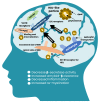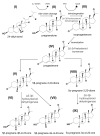Diversity of Plant Sterols Metabolism: The Impact on Human Health, Sport, and Accumulation of Contaminating Sterols
- PMID: 34066075
- PMCID: PMC8150896
- DOI: 10.3390/nu13051623
Diversity of Plant Sterols Metabolism: The Impact on Human Health, Sport, and Accumulation of Contaminating Sterols
Abstract
The way of plant sterols transformation and their benefits for humans is still a question under the massive continuing revision. In fact, there are no receptors for binding with sterols in mammalians. However, possible biotransformation to steroids that can be catalyzed by gastro-intestinal microflora, microbial cells in prebiotics or cytochromes system were repeatedly reported. Some products of sterols metabolization are capable to imitate resident human steroids and compete with them for the binding with corresponding receptors, thus affecting endocrine balance and entire physiology condition. There are also tremendous reports about the natural origination of mammalian steroid hormones in plants and corresponding receptors for their binding. Some investigations and reports warn about anabolic effect of sterols, however, there are many researchers who are reluctant to believe in and have strong opposing arguments. We encounter plant sterols everywhere: in food, in pharmacy, in cosmetics, but still know little about their diverse properties and, hence, their exact impact on our life. Most of our knowledge is limited to their cholesterol-lowering influence and protective effect against cardiovascular disease. However, the world of plant sterols is significantly wider if we consider the thousands of publications released over the past 10 years.
Keywords: anabolic effect; biotransformation; cholesterol; diet; food matrix; sterols.
Conflict of interest statement
The authors declared no competing or financial interests.
Figures





Similar articles
-
Diet micronutrient balance matters: How the ratio of dietary sterols/steroids affects development, growth and reproduction in two lepidopteran insects.J Insect Physiol. 2014 Aug;67:85-96. doi: 10.1016/j.jinsphys.2014.06.004. Epub 2014 Jun 19. J Insect Physiol. 2014. PMID: 24953330
-
Impact of colonic fermentation on sterols after the intake of a plant sterol-enriched beverage: A randomized, double-blind crossover trial.Clin Nutr. 2019 Aug;38(4):1549-1560. doi: 10.1016/j.clnu.2018.08.012. Epub 2018 Sep 7. Clin Nutr. 2019. PMID: 30243503 Clinical Trial.
-
Regulation of cholesterol metabolism by dietary plant sterols.Curr Opin Lipidol. 1999 Feb;10(1):9-14. doi: 10.1097/00041433-199902000-00003. Curr Opin Lipidol. 1999. PMID: 10095984 Review.
-
Effects of plant sterols and stanols on intestinal cholesterol metabolism: suggested mechanisms from past to present.Mol Nutr Food Res. 2012 Jul;56(7):1058-72. doi: 10.1002/mnfr.201100722. Epub 2012 May 24. Mol Nutr Food Res. 2012. PMID: 22623436 Review.
-
Biological transformations of steroidal compounds: a review.Steroids. 2012 Oct;77(12):1267-90. doi: 10.1016/j.steroids.2012.07.018. Epub 2012 Aug 13. Steroids. 2012. PMID: 22910289 Review.
Cited by
-
Bioactive Compounds from Pigmented Corn (Zea mays L.) and Their Effect on Health.Biomolecules. 2024 Mar 12;14(3):338. doi: 10.3390/biom14030338. Biomolecules. 2024. PMID: 38540758 Free PMC article. Review.
-
Nutritional Dermatology: Optimizing Dietary Choices for Skin Health.Nutrients. 2024 Dec 27;17(1):60. doi: 10.3390/nu17010060. Nutrients. 2024. PMID: 39796494 Free PMC article. Review.
-
Unveiling the "hidden quality" of the walnut pellicle: a precious source of bioactive lipids.Front Plant Sci. 2024 Jun 18;15:1395543. doi: 10.3389/fpls.2024.1395543. eCollection 2024. Front Plant Sci. 2024. PMID: 38957599 Free PMC article.
-
Desert Endemic Plants in Algeria: A Review on Traditional Uses, Phytochemistry, Polyphenolic Compounds and Pharmacological Activities.Molecules. 2023 Feb 15;28(4):1834. doi: 10.3390/molecules28041834. Molecules. 2023. PMID: 36838819 Free PMC article. Review.
-
Wild Mushrooms as a Source of Bioactive Compounds and Their Antioxidant Properties-Preliminary Studies.Foods. 2024 Aug 20;13(16):2612. doi: 10.3390/foods13162612. Foods. 2024. PMID: 39200539 Free PMC article.
References
Publication types
MeSH terms
Substances
Grants and funding
LinkOut - more resources
Full Text Sources
Miscellaneous

